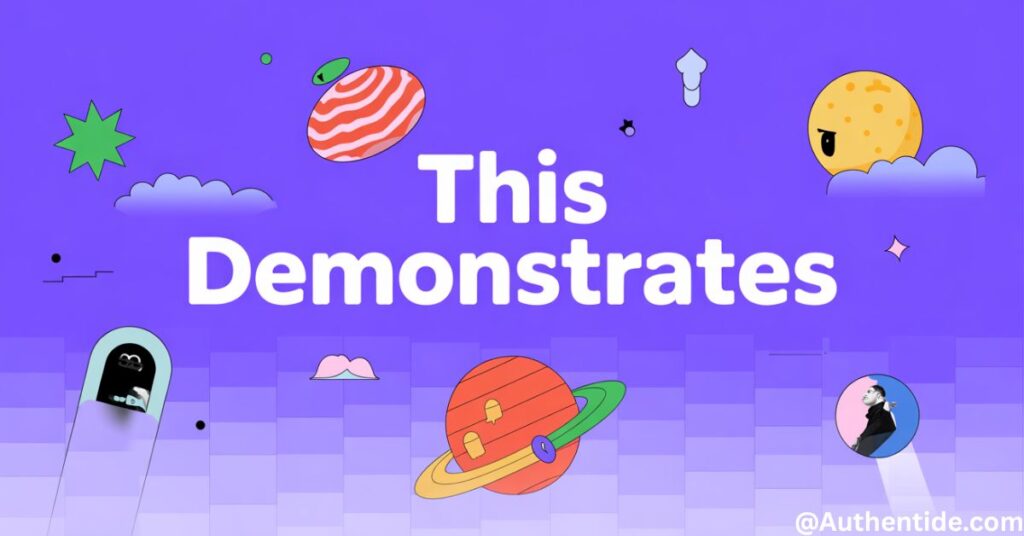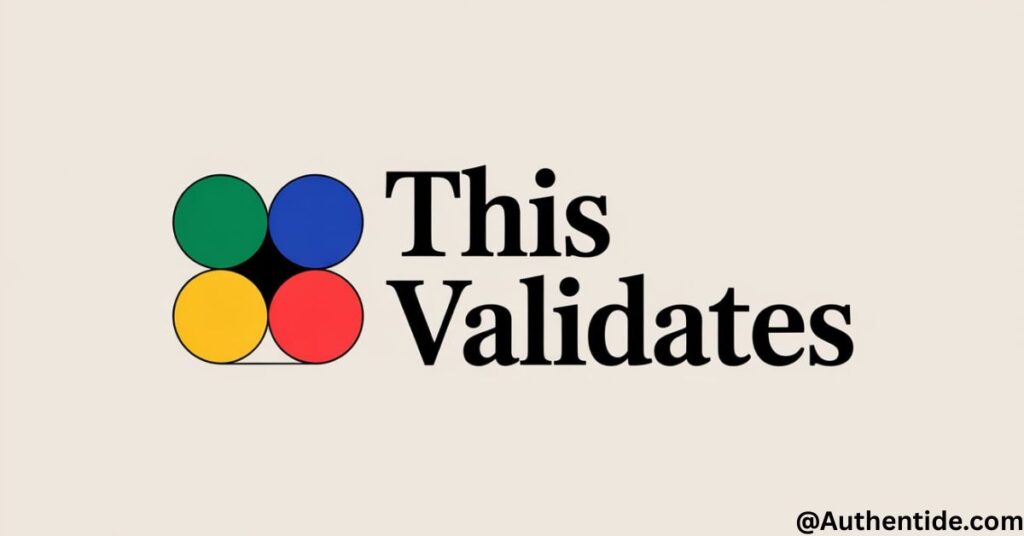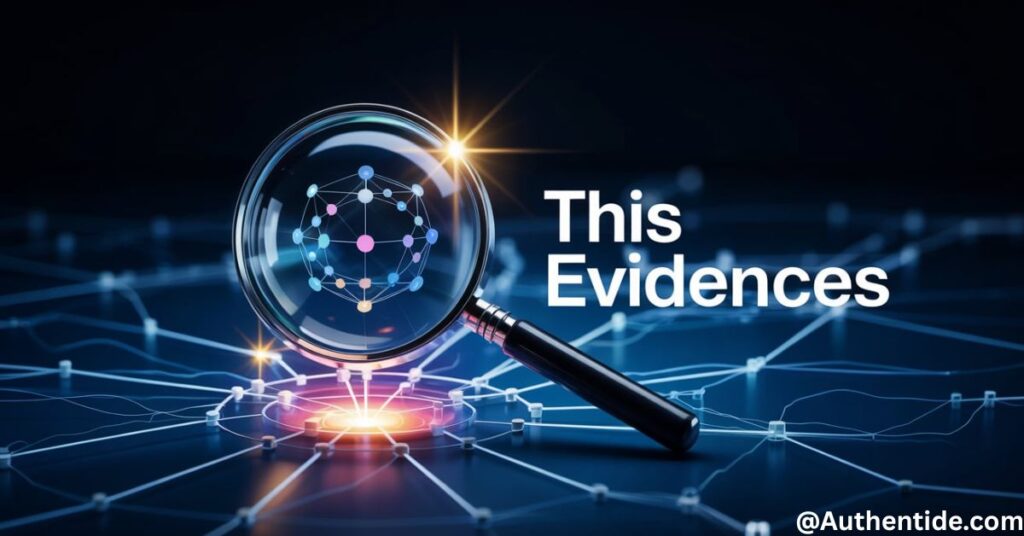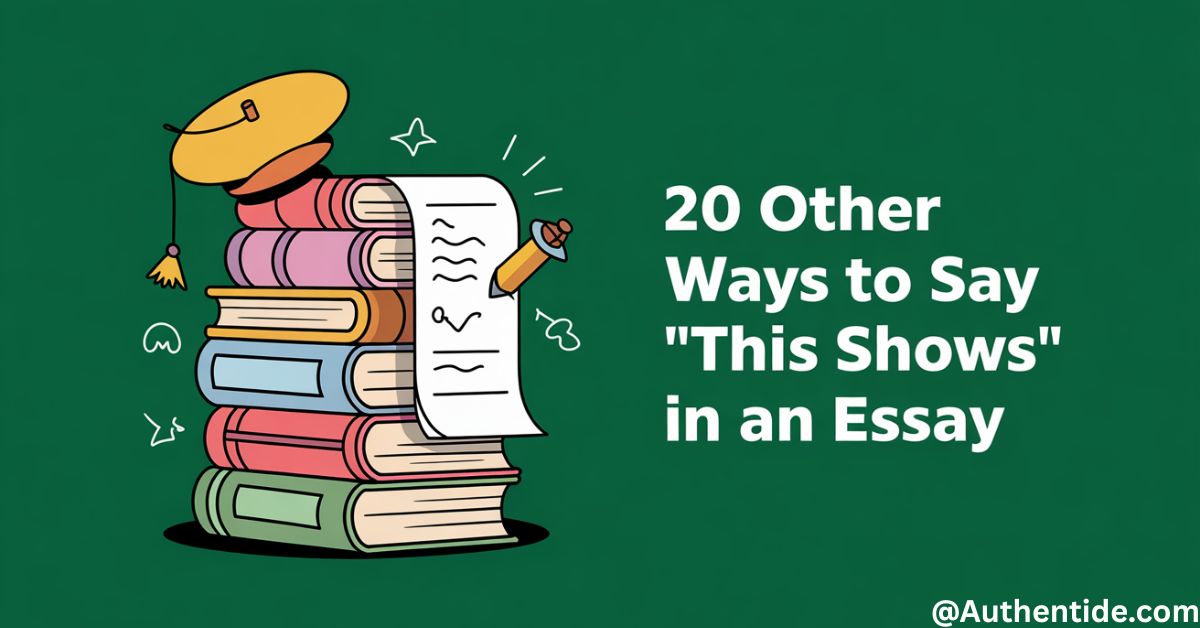Other ways to say “this shows” can transform your essay from basic to brilliant. When you’re crafting academic papers, the phrases you use to connect evidence to analysis make all the difference in how your arguments land. Repeating “this shows” throughout your work creates monotony and signals to professors that you’ve settled for the simplest option rather than showcasing your linguistic versatility.
Think about it your essay is like a guided tour through your thinking process. Your transition phrases are the signposts that help readers follow your logical path. By expanding your repertoire beyond “this shows,” you instantly elevate your writing style and demonstrate a sophisticated command of language. Just as a chef wouldn’t use the same spice in every dish, a skilled writer varies their transitional phrases to keep readers engaged.
Diversifying your language isn’t just about impressing professors; it’s about precision. Each alternative to “this shows” carries subtle differences in meaning and emphasis. Some options highlight causation more strongly, while others suggest correlation or implication. By selecting the perfect alternative, you can communicate the exact relationship between your evidence and conclusion, making your argument not just more engaging, but also more accurate and persuasive.
What to Say Instead of “This Shows”
- This demonstrates
- This indicates
- This suggests
- This reveals
- This proves
- This establishes
- This confirms
- This supports
- This underscores
- This exemplifies
- This illustrates
- This highlights
- This signifies
- This reinforces
- This substantiates
- This validates
- This corroborates
- This attests to
- This elucidates
- This evidences
is it Professional to Say: “This Shows”Edit
While “this shows” is grammatically correct and functional in academic writing, it often reads as elementary and lacks sophistication. Professional writing benefits from more precise alternatives that clarify the exact relationship between evidence and conclusions. Occasional use of “this shows” won’t damage your credibility, but consistently relying on this basic phrase can suggest limited vocabulary and analytical thinking. Elevating your transitions with more specific alternatives demonstrates linguistic versatility and enhances your professional communication style.
Why “This Shows” Needs Alternatives in Your Essay
When writing academic essays, the phrase “this shows” often becomes the go-to transition between evidence and analysis. While functional, this overused phrase can make your writing appear elementary and repetitive. Professors and instructors reading dozens of papers immediately notice when students rely on the same transitions throughout their work. Another way to say “this shows” isn’t just about variety it is about precision and sophistication.
Think about your essay as a professional conversation. In business communications, people don’t repeat identical phrases when making important points. Similarly, in formal essays, varied language demonstrates your command of English and your ability to express nuanced relationships between ideas. When you write “this shows” repeatedly, you miss opportunities to specify exactly how your evidence connects to your argument.
Strong academic writing requires transitions that do more than simply indicate a connection exists. The best transitions clarify the nature of that connection whether your evidence proves, suggests, indicates, or merely hints at your conclusion. By expanding your transition vocabulary, you create clearer logical connections between your evidence and claims, guiding your reader through your reasoning with precision.
Is “This Shows” a Good Phrase to Use in an Essay?
“This shows” isn’t inherently problematic it is clear and direct. However, its simplicity becomes a liability when overused. In polished writing, variety prevents reader fatigue and demonstrates linguistic versatility. Using “this shows” occasionally is fine, but relying on it exclusively suggests limited vocabulary and can make your essay writing style seem undeveloped.
The phrase also lacks specificity. How exactly does your evidence connect to your claim? Does it definitively prove your point, or merely suggest a possible interpretation? Alternative phrases can communicate these nuances more effectively, strengthening your supporting arguments and making your analytical process transparent to readers.
Consider too that professors and instructors read countless essays containing “this shows” in every paragraph. Making your writing stand out requires moving beyond these common phrases. Your goal should be communication that feels natural yet sophisticated language that wouldn’t seem out of place in published academic journals or professional reports.
20 Other Ways to Say “This Shows” in an Essay
Here are 20 Other Ways to Say “This Shows” in an Essay:
1. This demonstrates

“This demonstrates” adds a touch of formality while emphasizing the clear exhibition of evidence. It suggests a definitive connection between your evidence and conclusion.
Example scenario: In a literary analysis essay discussing character development: “The protagonist’s refusal to accept help, even when severely injured, demonstrates his pathological need for independence stemming from childhood trauma.”
2. This indicates
“This indicates” suggests pointing toward a conclusion without absolutely confirming it. It’s slightly more tentative than “shows” while maintaining professional tone.
Example scenario: In an email reporting marketing research findings to Sarah Rodriguez, department head: “The 40% increase in engagement when using question-based headlines indicates that our audience responds more positively to content framed as solving their specific problems rather than general information.”
3. This suggests
When evidence implies something without definitively proving it, “this suggests” acknowledges the interpretive step. It’s perfect for academic papers where measured claims are valued.
Example scenario: In a psychology research paper: “Participants who received positive reinforcement completed tasks 30% faster than the control group. This suggests that recognition may be a more powerful motivator than previously theorized in workplace productivity studies.”
4. This reveals
Use “this reveals” when your evidence uncovers or exposes something previously hidden or unknown, adding dramatic emphasis to your analytical point.
Example scenario: In a historical analysis essay: “The recently declassified documents from 1967 reveal that government officials were aware of the environmental dangers long before implementing safety regulations.”
5. This proves
When your evidence is conclusive and establishes your point beyond reasonable doubt, “this proves” confidently asserts the connection. Use sparingly and only with truly definitive evidence.
Example scenario: In a mathematical proof: “Since X cannot equal both 5 and 7 simultaneously while satisfying both equations, this proves that the system has no solution within the real number domain.”
6. This establishes

“This establishes” suggests creating a foundation or setting a precedent. It’s excellent for introducing fundamental concepts that later arguments will build upon.
Example scenario: In a legal studies essay: “The Supreme Court’s ruling in Brown v. Board of Education establishes that separate educational facilities are inherently unequal, fundamentally changing how equal protection is interpreted under the Fourteenth Amendment.”
7. This confirms
When your evidence verifies something previously suggested or suspected, “this confirms” emphasizes the validation of existing theories or expectations.
Example scenario: In a lab report email to Professor Chen: “Our third experiment produced identical results to the first two trials. This confirms that the reaction occurs consistently under standard atmospheric pressure, eliminating random error as an explanation for our observations.”
8. This supports
For evidence that backs your claim without necessarily proving it conclusively, “this supports” acknowledges the evidence strengthens your position while maintaining academic humility.
Example scenario: In a sociological analysis: “The correlation between early childhood education and decreased incarceration rates supports the theory that educational intervention represents a more effective long-term crime reduction strategy than increased policing.”
9. This underscores
“This underscores” suggests your evidence emphasizes or draws attention to an important point, adding weight to something already mentioned.
Example scenario: In a business proposal to Alexander Thompson: “The competitor’s 15% market share loss following their rebranding disaster underscores the critical importance of maintaining brand consistency when attempting to modernize corporate identity.”
10. This exemplifies
When your evidence serves as a perfect example of your claim, “this exemplifies” draws attention to how well it illustrates your point.
Example scenario: In an art history essay: “Picasso’s ‘Guernica’ with its fragmented forms and monochromatic palette exemplifies how Modernist artists used formal elements to convey emotional and political content rather than realistic representation.”
11. This illustrates
Similar to “exemplifies,” but with more emphasis on clarification or making something easier to understand through example.
Example scenario: In an educational psychology paper: “The dramatic improvement in test scores when students taught others illustrates the effectiveness of the ‘learning by teaching’ methodology compared to passive study techniques.”
12. This highlights

Use “this highlights” when your evidence draws attention to something particularly notable or significant within your broader argument.
Example scenario: In an environmental impact assessment sent to Director Williams: “The presence of microplastics in 90% of water samples highlights the pervasive nature of polymer pollution even in seemingly pristine wilderness areas.”
13. This signifies
“This signifies” suggests your evidence has symbolic importance or represents something beyond its immediate context.
Example scenario: In a cultural studies essay: “The protagonist’s journey from rural hometown to urban center signifies the broader societal shift from agricultural to industrial economies during this historical period.”
14. This reinforces
When your evidence strengthens or adds additional support to a point already established, “this reinforces” acknowledges the cumulative nature of your argument building.
Example scenario: In a marketing strategy email to Team Leader Jensen: “Customer feedback specifically mentioning our improved response times reinforces our decision to invest in expanding the customer service department rather than automating with chatbots.”
15. This substantiates
For evidence that provides substantial proof or solid ground for your claims, “this substantiates” emphasizes the robustness of your supporting material.
Example scenario: In a forensic analysis report: “The matching DNA profiles from both crime scenes substantiate the prosecution’s theory that the same perpetrator committed both offenses, despite their different methods.”
16. This validates

When your evidence confirms the truth or accuracy of something previously questioned, “this validates” emphasizes legitimization.
Example scenario: In a research methodology email to Dr. Patel: “The reproducibility of our results across three independent laboratories validates our experimental design and strengthens our confidence in these conclusions.”
17. This corroborates
“This corroborates” is ideal when your evidence confirms or gives support to existing evidence or statements, emphasizing agreement between multiple sources.
Example scenario: In a historical research paper: “The ambassador’s private correspondence, recently discovered in the national archives, corroborates eyewitness accounts that the treaty negotiations nearly collapsed on three separate occasions.”
18. This attests to
Use “this attests to” when your evidence serves as testimony or certification of your claim’s validity.
Example scenario: In a performance evaluation to Manager Rodriguez: “The team’s ability to deliver the project three weeks ahead of schedule while maintaining quality standards attests to their exceptional coordination and commitment to excellence.”
19. This elucidates
When your evidence clarifies or makes something more comprehensible, “this elucidates” emphasizes the explanatory power of your support material.
Example scenario: In a philosophy essay: “Kant’s distinction between phenomenal and noumenal realms elucidates why he believed certain knowledge of things-in-themselves remains impossible within his epistemological framework.”
20. This evidences

Though slightly more formal and less common in everyday speech, “this evidences” directly emphasizes the evidentiary nature of your support material.
Example scenario: In a legal brief: “The defendant’s cell phone location data placing them at the scene evidences their direct involvement, contradicting their alibi testimony.”
How to Choose the Right Alternative
Selecting the perfect replacement for “this shows” depends on several factors. First, consider the strength of connection between your evidence and conclusion. Is your evidence absolutely conclusive (proves, confirms), moderately strong (demonstrates, supports), or merely suggestive (indicates, suggests)?
Second, think about your rhetorical purpose. Are you trying to emphasize discovery (reveals, highlights), verification (validates, corroborates), or explanatory power (illustrates, elucidates)? Each alternative carries subtle connotations that can enhance your specific analytical goal.
The academic discipline also matters. Scientific writing often favors measured terms like “indicates” or “suggests” to acknowledge limitations, while philosophical arguments might lean toward “establishes” or “demonstrates” when building logical frameworks. Understanding disciplinary conventions helps you select appropriate alternatives.
Finally, consider variety and flow. Even with twenty alternatives, you’ll create monotony if you use the same three phrases repeatedly. Distribute different alternatives throughout your essay, choosing options that sound natural with your writing voice while maintaining clear connections between evidence and analysis.
Pro Tips for Implementing These Alternatives
Context matters when implementing other words for “this shows” in an essay. The strongest alternatives create a logical bridge between specific evidence and your analytical point. Don’t just swap in alternatives randomly—choose phrases that reflect the actual relationship between your evidence and conclusion.
Paragraph placement affects which alternatives work best. Opening paragraphs often benefit from more tentative language (“suggests,” “indicates”) as you begin building your case. Conclusion paragraphs can use stronger alternatives (“demonstrates,” “confirms”) once you’ve established multiple supporting points.
Combine alternatives with specific references to strengthen clarity. Instead of simply writing “This demonstrates,” try “This statistical anomaly demonstrates” or “These conflicting accounts reveal.” This technique precisely identifies which evidence you’re connecting to your analytical point.
Read your transitions aloud to ensure they sound natural. Another word for “this shows” should improve your essay, not make it sound artificially complicated. If a transition feels awkward or pretentious when spoken, try a simpler alternative.
Frequently Asked Question
How do you say “shows” in an essay?
In an essay, instead of saying “shows,” you can use words like “demonstrates,” “illustrates,” “reveals,” “highlights,” or “indicates.”
What is a better way of saying “this show”?
A better way of saying “this show” could be “this presentation,” “this program,” “this performance,” or simply “this production,” depending on the context.
How do you mention a show in an essay?
To mention a show in an essay, you should italicize the title and use proper capitalization.
For example: Breaking Bad or The Crown.
What is a better word for show?
A better word for “show” could be “performance,” “exhibition,” “presentation,” “display,” or “production,” depending on what you mean.
Final Thoughts
Mastering alternative phrases to replace “this shows” represents just one aspect of developing a sophisticated essay writing style. The best academic writers understand that effective transitions don’t just connect ideas they clarify relationships between evidence and arguments, guide readers through complex reasoning, and demonstrate linguistic versatility.
Remember that the goal isn’t simply to avoid repetition but to communicate with greater precision. Each alternative in this list carries subtle differences in meaning that, when used thoughtfully, can transform adequate writing into exceptional analysis. By expanding your transitional vocabulary, you’re not just impressing professors you’re developing more nuanced thinking.

Your go-to place for smart synonyms and celebrity updates. Muhammad Hassan Abid is dedicated to creating useful, engaging content that informs, inspires, and truly serves your curiosity

